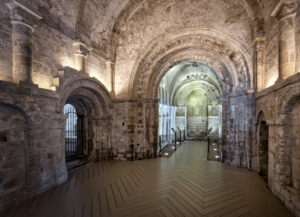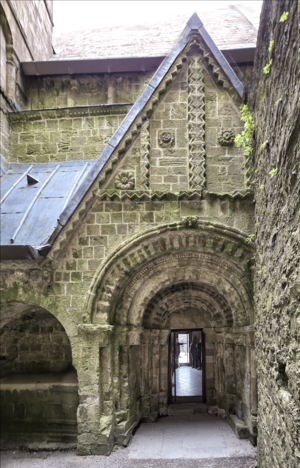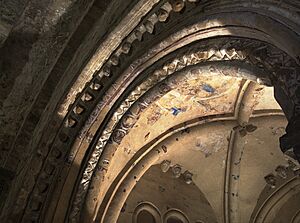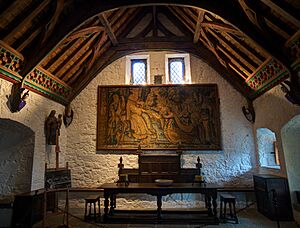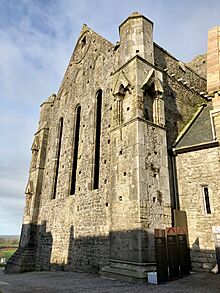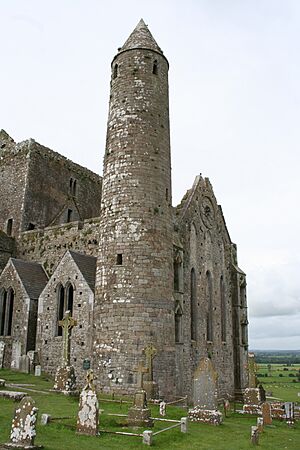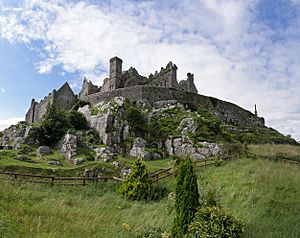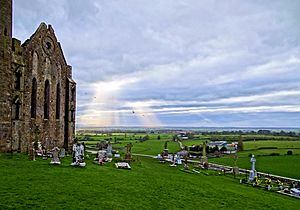Rock of Cashel facts for kids
The Rock of Cashel is a famous historical site in Cashel, County Tipperary, Ireland. It's also called Cashel of the Kings or St. Patrick's Rock. This amazing place sits high up on a rock, looking over the flat land around it. It's a very important landmark in Irish history.
Contents
History of the Rock of Cashel
Local stories say that the Rock of Cashel came from a mountain called the Devil's Bit. This mountain is about 30 kilometers (20 miles) north of Cashel. The legend says that Saint Patrick chased Satan from a cave there. When Satan left, the Rock landed in Cashel.
According to an old book called Tripartite Life of Saint Patrick, Saint Patrick visited Cashel in the 5th century. He is said to have converted the King of Munster to Christianity there.
Early Kings and Church Ownership
The Rock of Cashel was the main home for the kings of Munster for a long time. This started as early as the 4th century. The Eóganachta clan built a strong fortress at Cashel in the 5th century. They ruled from there for hundreds of years.
In 977, a famous king named Brian Boru was crowned king at Cashel. He made Cashel his capital city. Later, in 1101, the King of Munster, Muirchertach Ua Briain, gave his fortress on the Rock to the Church.
This beautiful group of buildings has a unique style. It shows some of the best Celtic art and medieval architecture in Europe. Most of the buildings you see today were built in the 12th and 13th centuries. Not many parts of the very first structures are left.
Buildings on the Rock of Cashel
The Rock of Cashel has several important buildings. Each one tells a part of Ireland's history.
Cormac's Chapel: A Special Design
Cormac's Chapel was built for King Cormac Mac Carthaigh. Construction started in 1127 and it was officially opened in 1134. This chapel is very well-designed. It has arched ceilings and wide doorways. Its style was inspired by European architecture of the time, but it also has special Irish touches.
An Irish Abbot (a leader of a monastery) from Germany, Dirmicius of Regensburg, sent two carpenters to help build it. The two towers on either side of the chapel's middle section show their German influence. This kind of twin tower design is rare in Ireland.
Other cool things about the chapel include:
- Arches inside and outside the building.
- A rounded ceiling.
- Carved stone above the doorways.
- A beautiful north doorway.
- The oldest stairs in Ireland.
It also has the only Romanesque frescoes (wall paintings) left in Ireland. The chapel was built with sandstone. Over many years, the stone got very wet, which damaged the paintings. To fix and protect them, the chapel was covered with a special rain-proof structure. Dehumidifiers were used inside to dry out the stone. Now, you can take limited tours to see it.
The Cathedral: A Grand Structure
The main cathedral was built between 1235 and 1270. It is a large church shaped like a cross, but it doesn't have side aisles. It has a central tower and a big castle at its western end.
The Hall of the Vicars Choral was built in the 15th century. This hall holds the tall St. Patrick's Cross, which is over 2 meters (7 feet) high. The vicars choral were people who helped sing the church services. At first, there were eight vicars choral at Cashel. Later, this number was reduced to five. They hired other singers to help them. This continued until 1836.
The Office of Public Works restored the Hall in 1975. This was part of a project for European Architectural Heritage Year. Today, visitors enter the site through this hall.
A Difficult Time for the Cathedral
In 1647, during the Irish Confederate Wars, the English Parliamentarian troops attacked Cashel. This event is known as the Sack of Cashel. The Irish soldiers and Catholic priests, including Theobald Stapleton, were killed. The English troops also stole or destroyed many important religious items.
Later, around the 1730s, the main roof of the cathedral was destroyed. This was done by Arthur Price, who was the Anglican Archbishop of Cashel at the time. People criticized his decision to remove the roof, both then and now. The cathedral had been called a "jewel" among Irish church buildings.
Today, the Rock of Cashel is a popular place for tourists to visit. In 2011, Queen Elizabeth II visited the Rock of Cashel during her trip to Ireland.
The Round Tower: An Ancient Landmark
The oldest and tallest building on the Rock is the well-preserved round tower. It is about 28 meters (92 feet) high and was built around 1100. The entrance to the tower is about 3.7 meters (12 feet) off the ground. This was common for round towers because they had shallow foundations.
The tower was built using a method called dry stone, meaning stones were fitted together without mortar. However, for safety reasons, modern experts have filled some parts of the tower with mortar to make it stronger.
Other Features of the Site
The entire area where the buildings and graveyard are located is surrounded by a wall. In the grounds around the buildings, there is a large graveyard. It has many high crosses.
One of the most famous crosses is Scully's Cross. It was built in 1860 to remember the Scully family. Sadly, in 1976, lightning struck a metal rod inside the cross and destroyed it. The top part of the cross now lies at its base, next to the rock wall.
See also
 In Spanish: Roca de Cashel para niños
In Spanish: Roca de Cashel para niños
- Eóganachta
- Hore Abbey
- Kings of Desmond
- Synod of Cashel
- National monuments of Ireland






